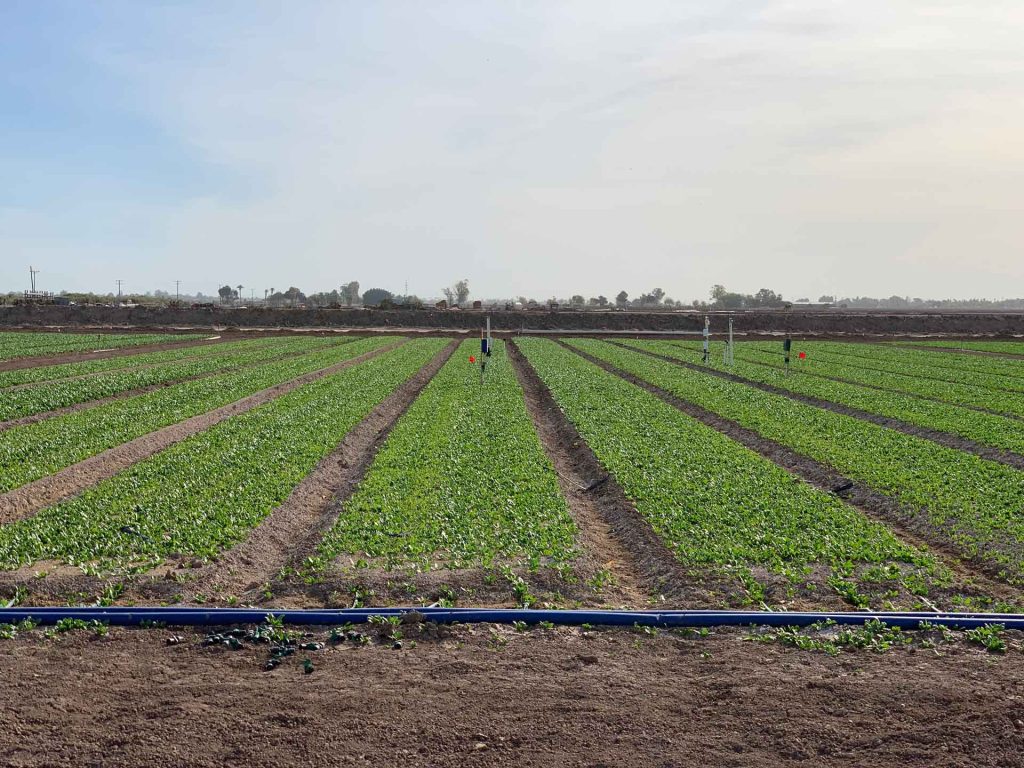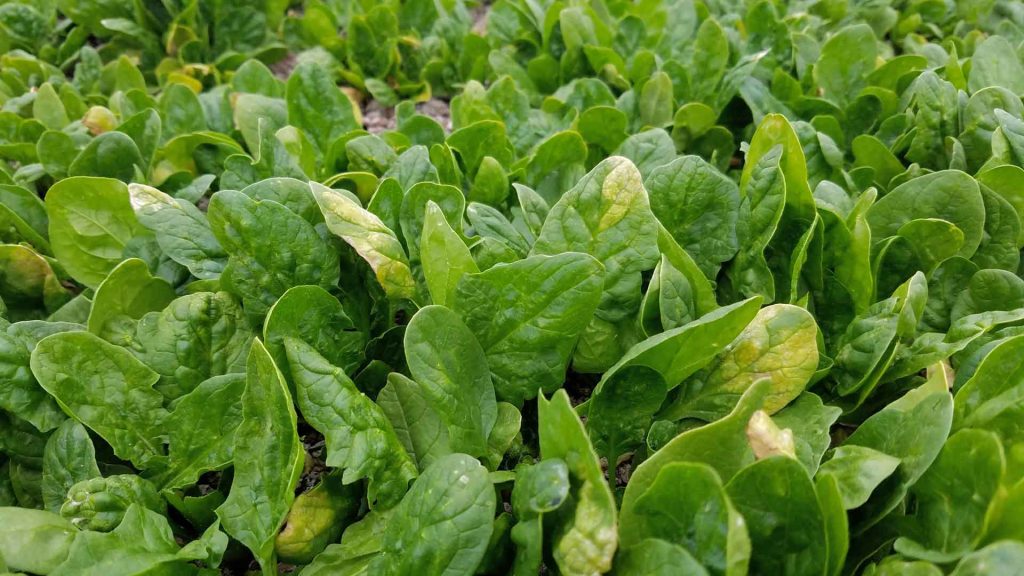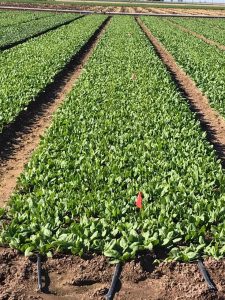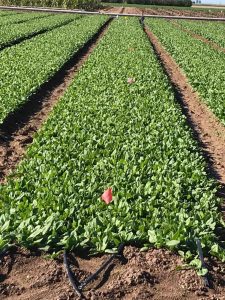Introduction
Spinach (Spinacia oleracea) is a leafy green quick-maturing, cool-season vegetable crop. Most conventional and organic spinach fields are irrigated by solid-set or hand-move sprinklers. However, overhead irrigation could contribute to the speed and severity of downy mildew epidemics within a field when other conditions such as temperature are favorable. Downy mildew on spinach is a widespread and very destructive disease in California. It is the most important disease in spinach production, in which crop losses can be significant in all areas where spinach is produced. In the low desert of California, spinach downy mildew typically occurs between mid-December and the end of February. Although fungicides are available for the control of downy mildew in conventional production systems, products with similar efficacy are not available for organic production. Therefore, additional strategies are needed to reduce disease pressure, including irrigation managements.
It is postulated that new irrigation management techniques and practices in spinach production may have a significant economic impact to the leafy greens industry through the control of downy mildew. In addition to reducing losses from plant pathogens, new irrigation practices could reduce risks to food safety (risks caused by overhead application of irrigation water). For instance, adapting drip irrigation for high density spinach plantings could be a possible solution to reduce losses from downy mildew, improve crop productivity and quality, and improve crop water and fertilizer use efficiency. Currently, no one uses drip irrigation for spinach, and there is a lack of information on the viability of drip irrigation technology in spinach. This project aims to evaluate the viability of drip irrigation for organic spinach production and assess its impact on the management of spinach downy mildew.
Field experiment
The field experiment was conducted over two crop seasons (fall 2018 and winter 2019) at the University of California Desert Research and Extension Center in Holtville, California (Fig.1). Two dripline spacings (three and four driplines per 80-inch bed) was studied versus sprinkler irrigation as control treatment. A comprehensive data collection was carried out to fully understand the differences between the irrigation treatments. Untreated Viroflay spinach seeds were planted in both seasons. True 6-6-2 (a homogeneous pelleted fertilizer) and True 4-1-3 (a liquid fertilizer) were applied as pre-plant fertilizer and as complementary fertilizer through injection into irrigation systems, respectively. The emitter spacing on the dripline was 8-inch with nominal flow rate of 0.13 gph (gallons per hour) at 8 psi (pounds per square inch). The beds were 80-inch wide by 200 feet long. The experiment was arranged in a randomized complete block design with four replications. All treatments were germinated by sprinklers. In the winter trial, 6-spinach bed was germinated and irrigated using drip irrigation (four driplines per 80-inch bed) the entire crop season to evaluate the possibility of using drip for throughout crop season including plant establishment.

Fresh biomass yield
In the fall trial, mean fresh biomass yield for the sprinkler treatment was 12,406 lb/ac (pound/acre), approximately 9 percent more than the 4-dripline in bed treatment (Table 1). In the winter trial, mean fresh yield in the sprinkler treatment was 13,281 lb/ac, approximately 7 percent more than the 4-dripline in bed treatment. Statistical analysis showed very strong evidence for an overall effect of irrigation system on spinach fresh yield in both the fall and winter trials. While we couldn’t find a significant difference between the sprinkler and the 4-dripline per bed treatment on spinach biomass yield in the winter trial, there was statistically significant yield differences between the sprinkler and the 3-dripline irrigation treatments in this trial. Fig. 2 shows a visual comparison of the drip treatments versus the sprinkler treatment 38 days after planting.
The yield difference between drip irrigation treatments and the sprinkler irrigation ranged between 7 percent (the 4-dripline per bed treatment against the sprinkler treatment in the winter trial) and 13 percent (the 3-dripline per bed treatment against the sprinkler treatment in the fall trial). The yield difference may have likely been caused by irrigation and nutrient management conditions of the drip treatments. Since drip irrigation was tested for the first time for spinach, subsequent trials need to plan for improvements and be conducted in different aspects. However, the 7 percent yield difference between the drip treatment (4-dripline per bed) and the sprinkler treatment demonstrates the potential of drip irrigation for a profitable spinach production. This yield difference could be reduced through optimal system design and a better irrigation and nutrient management practices for drip system.
| Fall 2018 | Winter 2019 | ||
| Irrigation treatment | Fresh yield (lb/ac) | Irrigation treatment | Fresh yield (lb/ac) |
| Sprinkler | 12,406 a | Sprinkler | 13,281 a |
| 4-dripline per bed | 11,378 b | 1.5D-4B | 12,414 ab |
| 3-dripline per bed | 10,950 b | 1.5D-3B | 12,116 b |
Table 1. Mean spinach fresh yield values of each irrigation treatment in each of the fall and winter experiments. Yields with different letters significantly differ (p < 0.05) by Tukey’s test.
Downy Mildew
Downy mildew was not observed in the fall trial but detected in the winter trial on March 5, 2019 (Fig. 3). Downy mildew disease incidence was low on March 11, 2019, with only two beds exhibiting incidences above 0.1 percent level. Mean downy mildew incidence in sprinkler irrigated plots following seedling emergence was approximately 3 to 11 times higher than treatments irrigated with drip following emergence. Statistical analysis indicated strong evidence for an overall effect of irrigation treatment on downy mildew.

The most likely mechanism for variations in spinach downy mildew incidences is the reduction in leaf wetness under drip irrigation, which is critical for infection and sporulation by the downy mildew pathogen. For instance, the data of leaf wetness sensors revealed that sprinkler irrigated crop canopies remained wet for 24.3 percent more time than crop canopies under the drip treatment at a period of 12 days over the fall season experiment (Fig. 4).

Other Observation and Lessons Learned
At the winter trial, a germination rate test was conducted 10 days after planting to evaluate the germination rate of the sprinkler irrigation (germinated by sprinkler) and beds germinated by drip irrigation. Although plots germinated by drip were not sufficiently replicated and were not randomized among plots with other treatments, it was worth-while to have an initial idea of germinating spinach with drip irrigations for future experiments. Spinach germination under drip irrigation was approximately three days late compare to the plots germinated by sprinkler irrigation. Spinach germination rate for the beds drip irrigated was averagely 3 percent lower than the sprinkler irrigated beds.
The developed canopy crop curves showed that the leaf density of drip irrigation treatments (germinated by sprinkler) was slightly behind (1-4 days depending upon the irrigation treatment and crop season) that of sprinkler irrigation treatment in time.
In late November 2018, more differences were observed among the treatments in several of the beds, mainly yellowing of leaves in between driplines (especially the 3-dripline per bed treatment). A possible reason may be that the fertigation did not move the nitrogen between the driplines. The values of total plant nitrogen content and leaf chlorophyll content demonstrated that nitrogen uptake at the drip treatments was not as effective as the sprinkler treatment, particularly in the fall experiment. Nutrient management issue in spinach drip irrigation in combination with water management is likely a critical issue that we need to address, while it may affect the adoptability and viability of drip for spinach production.
Conclusions
Drip irrigation demonstrated the potential to be used to produce organic spinach, conserve water, enhance the efficiency of water use, and reduce downy mildew disease incidences. Statistical analysis of the data collected indicated a strong evidence for overall variation in irrigation system on spinach fresh biomass yield and downy mildew disease incidences. A lower spinach yield could be likely caused by irrigation and nutrient management conditions under the drip irrigation at this point, where it is tried for the first and initial time. Subsequent drip irrigation trials for spinach production trials can be optimized with improved practices when using drip irrigation. Similarly, yield difference between drip and in sprinkler irrigated spinach could be reduced through optimal system design and better irrigation and nutrient management practices in drip irrigation system. The results also demonstrated an overall effect of irrigation treatment on downy mildew, in which downy mildew incidence was lower in plots irrigated by drip following emergence when compared to sprinkler.
Further work is needed to comprehensively evaluate the viability of utilizing drip, specifically optimal system design, the impacts of irrigation and nitrogen management practices in various soil types and climates, and strategies to maintain productivity and economic viability of spinach. Assessing drip irrigation for the entire crop season, germination and remainder of crop season, could be another research interest since spinach is a short season crop and combining sprinkler (for crop germination) and drip for such a short period might cause some practical issues.
Acknowledgement: This research was supported by the California Leafy Greens Research Board.






